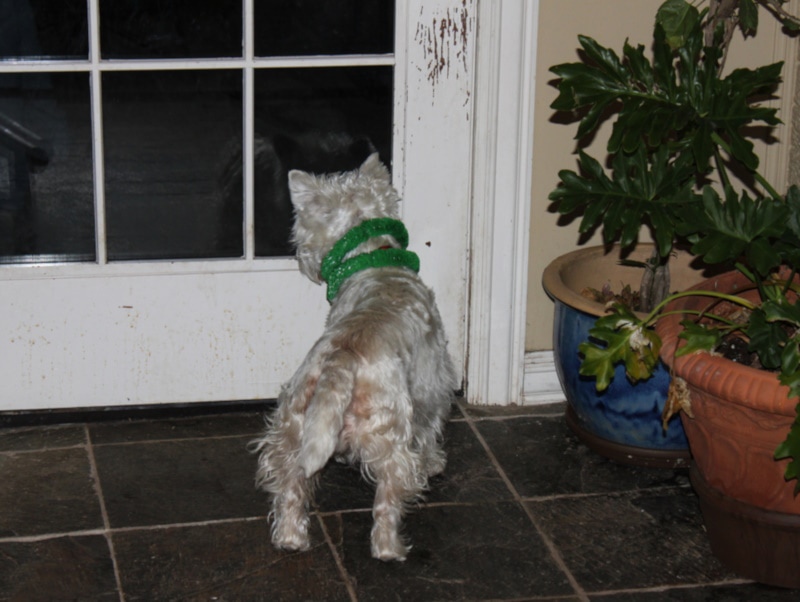[ad_1]
Canines scratching at doorways is a typical conduct, nonetheless it would smash your as quickly as attractive and clear doorways. Finally, your doorways will placed on skinny with repeated placed on in a single spot, to not level out the annoying sound of canine nails scraping. Canines moreover run the possibility of getting nail accidents from scratching, significantly with inside wooden doorways.
Fortuitously, it’s simple to teach your canine to not scratch at doorways. The underside line is incentivizing appropriate conduct and discouraging undesirable conduct—on this case, scratching at doorways. Listed under are some methods to coach your canine to not scratch.


The 7 Tips to Maintain Your Canine From Scratching the Door
1. Give Your Canine Retailers for Vitality
Some canine scratch resulting from boredom, nervousness, frustration, or attention-seeking behaviors. In case you’re employed prolonged hours and your canine is alone, it’s attainable that they’ll uncover retailers for his or her additional energy. Normally, this means dangerous behaviors like scratching at doorways.
It’s possible you’ll forestall this conduct by taking your canine for prolonged walks. A drained canine is a peaceable canine that is a lot much less extra more likely to channel energy into ruining your points. Strolling your canine can be good for bonding, significantly in case you allow your canine to scent and uncover their surroundings.


2. Prioritize Playtime
Prepare may additionally assist your canine, nonetheless they need additional than merely bodily stimulation. Playtime and training help tire your canine out mentally, serving to to cease boredom and improve your bond. Play courses like fetch, tug-of-war, a troublesome puzzle sport, and even going by some elementary obedience and suggestions will give your canine the attention they need whereas moreover sparing your doorways from damage.
3. Redirect the Habits
Canines are good learners. It’s possible you’ll reinforce the conduct you want—every intentionally and unintentionally—in the way in which you react. As an example, in case you ignore your canine until they scratch on the door after which yell or scold, they’ve succeeded in getting your consideration. Even unfavorable consideration is an enchancment over no consideration.
The intention of redirecting conduct is rewarding the conduct you want by substituting good points for unhealthy points. With scratching, you’ll redirect your canine to scratch a scratch pad in its place of the door. Interrupt your canine whereas scratching by calling them over and offering the selection, then rewarding them after they work together with that in its place of the door. Over time, your canine will likely be taught that the model new conduct (scratching a scratch pad) is preferable to the door.


4. Go away Them With Pleasant Distractions
Some canine don’t favor to be alone. If it is a should to be gone for a really very long time, give your canine one factor to take up the time and focus their energy. As an example, hiding treats spherical the house and allowing your canine to hunt for them while you’re gone takes loads of psychological focus and energy. Puzzle toys or lick mats are moreover good decisions to keep up your canine occupied.
It’s essential to be careful with what you allow whereas your canine is alone, nonetheless. Some toys or chews shouldn’t be given unsupervised, resembling deer antlers or squeak toys in case your canine is a dangerous chewer. Moreover, in case you’ve gotten various canine within the an identical household, avoid toys or actions which will set off them to battle over belongings.
5. Don’t Reward Harmful Habits
Consistency is significant to canine teaching. Even in case you don’t suggest to, you’ll by probability reinforce the scratching conduct. As an example, in case your canine scratches and likewise you immediately take them out for a stroll or to play, they’ll be part of that scratching will get them what they want.
Instead, wait until your canine stops scratching the door for a second. Then, you’ll work together and reward a model new conduct. You have to reward them by stopping, not by probability connecting the scratching with pleasant actions and rewards.


6. Don’t Punish the Habits
Punishment like yelling at or hitting your canine doesn’t practice them to stop. It has a unfavorable influence, significantly in case your canine is anxious, as a result of it solely worsens the feelings of stress, nervousness, and concern. It might be reinforcing a conduct since your canine will get some consideration. In case you catch your canine in the middle of scratching or another dangerous conduct, interrupt them by calling the canine’s title and redirecting them.
7. Set up Underlying Causes
A canine that scratches at a door could merely be looking for consideration or attempting to get to you, nonetheless there may presumably be totally different causes. Part of correcting the conduct is managing triggers. Typically, a canine will scratch at a door because of there are totally different canine, cats, vermin, or wildlife exterior that they should get to. Managing this conduct could include putting up limitations so your canine can’t see exterior or having fun with music while you’re gone to attenuate exterior sounds whereas moreover teaching your canine to favor totally different behaviors.
In case your canine scratches the door out of separation nervousness, that could be more durable to acceptable. Canines which have separation nervousness will even pant or tempo while you’re gone. Separation nervousness solely worsens with time and with out remedy. It’s most interesting to hunt the recommendation of with a veterinary behaviorist to get a conduct modification plan which is able to include remedy to alleviate nervousness whereas engaged on teaching.
In case you concerned about your canine conduct we advise speaking with a vet
💛 🐶 Converse To a Vet On-line From the Comfort of Your Couch!
If it is important talk with a vet nonetheless can’t get to at the least one, head over to PangoVet. It’s a web-based service the place you’ll communicate to a vet on-line and get the custom-made advice you need in your pet — all at an fairly priced worth!


Must My Canine Be Crated?
In case your canine reveals dangerous behaviors like scratching the door, a crate or X-pen may very well be a lifesaver in your residence. It’s possible you’ll maintain your canine away from triggers and defend every them and your door from damage while you’re away.
That acknowledged, it’s not enough to put your canine throughout the crate and depart them for hours on end. Crate teaching accurately takes weeks or months of effort. Take your time with introducing the crate and using crate video video games to assemble a optimistic affiliation. Finally, your canine may favor to sleep of their crate with the door open.
Moreover, avoid using the crate as a kind of punishment. In case your reply is to put your canine throughout the crate as a “day journey” for unhealthy conduct, they’ll under no circumstances affiliate it with a spot of comfort or security. Worse however, their nervousness will solely enhance everytime you try and put them in it.
That acknowledged, in some situations, the perfect reply to the sort of conduct is to make it bodily unimaginable for the canine to achieve their aim of destruction so a gate or barrier is more likely to be one factor to consider.


Summary
A canine that scratches at doorways may very well be annoying at most interesting, nonetheless they’ll do crucial damage to your doorways or injure themselves at worst. With fixed teaching, enrichment, and optimistic reinforcement, you’ll follow your canine to stop scratching your doorways and develop a stronger bond throughout the course of.
Featured Image Credit score rating: Vineyard Perspective, Shutterstock
[ad_2]

This article offers practical solutions for a common issue among dog owners. The advice about understanding the underlying causes of scratching is something I hadn’t considered before, and I’m looking forward to implementing these ideas.
The article provides some useful strategies for dog owners dealing with scratching behavior. I appreciate the emphasis on positive reinforcement, as it seems more effective than punishment. It’s important to understand our pets’ needs.
I found the tips on providing distractions for dogs particularly helpful. It makes sense that keeping them engaged can reduce unwanted behaviors like scratching at doors. I’m definitely going to try some of these suggestions.
It’s interesting to read about the various factors that can lead to a dog scratching at doors. The recommendations provided seem straightforward and actionable, which is great for anyone looking to improve their dog’s behavior.
Overall, this piece presents a balanced approach to dog training. I appreciate how it highlights the importance of addressing both physical and mental stimulation in preventing destructive behavior. It’s a good reminder for all pet owners.